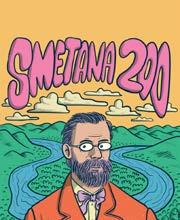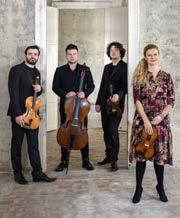
SMETANA, MOZART AND BARBER
14 Mar 2024
Victoria Concert Hall


14 Mar 2024
Victoria Concert Hall
Musicians of the SSO MOZART
Tseng Chieh-An violin
Nikolai Koval violin
Janice Tsai viola
Jamshid
Chen Da Wei violin
Xu Jueyi violin
Shui Bing viola
Guo Hao cello SMETANA
Zhao Tian violin
Zhang Si Jing violin
Chan Yoong-Han viola
Christopher Mui cello
CONCERT DURATION: approximately 1 hr and 30 mins (including 20 mins intermission)

Since its founding in 1979, the Singapore Symphony Orchestra (SSO) has been Singapore’s flagship orchestra, touching lives through classical music and providing the heartbeat of the cultural scene with its 44-week calendar of events. The SSO is led by Music Director Hans Graf, the third in the orchestra’s history after Lan Shui (1997-2019) and Choo Hoey (1979-1996).
In addition to its subscription series concerts, the orchestra is well-loved for its outdoor and community appearances, and its significant role educating the young people of Singapore. The SSO has also earned an international reputation for its orchestral virtuosity, having garnered sterling reviews for its overseas tours and over 50 recordings, culminating in its 3rd place win in the prestigious Gramophone Orchestra of the Year Award 2021. In 2022, BBC Music Magazine named the SSO as one of the 21 best orchestras in the world.
The SSO performs over 60 concerts a year at such venues as the Esplanade Concert Hall and Victoria Concert Hall in Singapore. Bridging the musical traditions of East and West, Singaporean and Asian musicians and composers are regularly showcased in its concert seasons. Its versatile repertoire spans alltime favourites and orchestral masterpieces to exciting cutting-edge premieres.
The SSO is part of the Singapore Symphony Group, which also manages the Singapore Symphony Choruses, the Singapore National Youth Orchestra, and the VCHpresents chamber music series, the Singapore International Piano Festival and the biennial National Piano & Violin Competition.
© Jack Yam(1756 – 1791)
String Quartet No. 19 in C major, K. 465 “Dissonance”
I. Adagio – Allegro
II. Andante cantabile
III. Menuetto. Allegretto
IV. Allegro molto
Mozart’s “Dissonance” Quartet gets its nickname from its mysterious opening, which, for its time, was so far beyond the norms of established harmonic practice that it immediately became his most famous string quartet. The highly unusual introduction, only about a minute and a half long, contains dense chromaticisms and false relations, and almost sounds like Richard Strauss! It refuses to settle in a single key until the bright C major Allegro begins properly. The last of six quartets that the 20-something Mozart dedicated to Joseph Haydn, it must surely have shocked the elder musician.
The rest of the first movement is much more conventional, being written in sonata form. By now Mozart had moved firmly away from the more monophonic style in his earlier quartets, and throughout the three movements, the four players stand on a much more equal footing, even if the cello still largely plays the bass line. Bits of melodic imitation filter through the texture, and the result is a much fuller sound throughout, especially noticeable in the outer movements, which display Mozart at his most exuberant.
String Quartet in B minor, Op. 11
I. Molto allegro e appassionato
II. Molto adagio
III. Molto allegro
Barber’s string quartet is best known just for its middle movement, which ended up as the famous Adagio for Strings. The whole work had a rather difficult gestation period, Barber rewriting the finale multiple times over the course of nearly a decade, revising it twice even after its premiere in 1936. He did, however, know that he had written a fantastic slow movement, describing it in a letter: “it is a knockout!”
There is a lot of music in this quartet that is clearly influenced by the more modernist tendencies of European art music in the inter-war period, when Barber was living in Austria, and some of the string writing in the faster passages, while not completely atonal, definitely stretch the tonality close to breaking point. The lyrical and chorale sections have the “openness” of sound that seems to define 20thcentury American classical music, with strongly diatonic harmonies and modal inflections.
For audiences familiar with the rich orchestral sound of the great Adagio, the comparatively pared-back forces of a string quartet might come as a surprise: there are far fewer doublings and the sound is much less rich. The possibility of hearing each individual player’s vibrato and bow strokes gives this movement a real fragility. After this emotional moment, the finale
comes as a brusque surprise: Barber kept shortening it as he revised it, but it still manages to recall themes from the previous movements, tying the quartet up in a neat package.
String Quartet No. 2 in D minor
I. Allegro
II. Allegro moderato
III. Allegro non più moderato, ma agitato e con fuoco
IV. Presto
Smetana’s second string quartet, quite overshadowed by his first, was written well after he became deaf: he never heard a note of it. Like Beethoven, for whom musicologists love to ascribe the agitation in his music to that same affliction, this quartet is at turns frantic and resigned, belligerent and calm. The first movement brings this conflict to the forefront and avoids a neat ending, before heading into the rather jagged folk dance of the next movement.
Even the quiet moments in the second movement do not last long. The third movement takes that slight sense of unease and runs amok right from the start, then tries on a poker-faced academic front with a fugato section, but nothing ever quite settles; the finale goes back into folk mode, but strange contrasts show how frustrated Smetana was with his life at that point. He would end his days in the Prague Asylum only a few months after the premiere.
Programme notes by Thomas Ang

ORGAN
CHAMBER

CREATION DANCE –RICHARD BRASIER
23 Mar, 7.30pm
Richard Brasier organ
SMETANA AND DVOŘÁK
17 May, 7.30pm
Musicians of the SSO
CHAMBER

CHAMBER


The vision of the Singapore Symphony Group is to be a leading arts organisation that engages, inspires and reflects Singapore through musical excellence. Our mission is to create memorable shared experiences with music. Through the SSO and its affiliated performing groups, we spread the love for music, nurture talent and enrich our diverse communities.
The SSO is a charity and not-for-profit organisation. You can support us by donating at www.sso.org.sg/donate
THE PAVEL HAAS QUARTET
19 May, 7.30pm
Pavel Haas Quartet
POETRY OF THE HARP –XAVIER DE MAISTRE
22 May, 7.30pm
Xavier de Maistre harp
THE CROW AND THE DOVE
15 Jun, 2pm & 5pm
Phoon Yu organ
Eudenice Palaruan percussion
Margaret Chen narrator
Ane Lagumen choreographer
Jos Daniel Andes dancer
Jos David Andes dancer
Ana Graciela Andes dancer